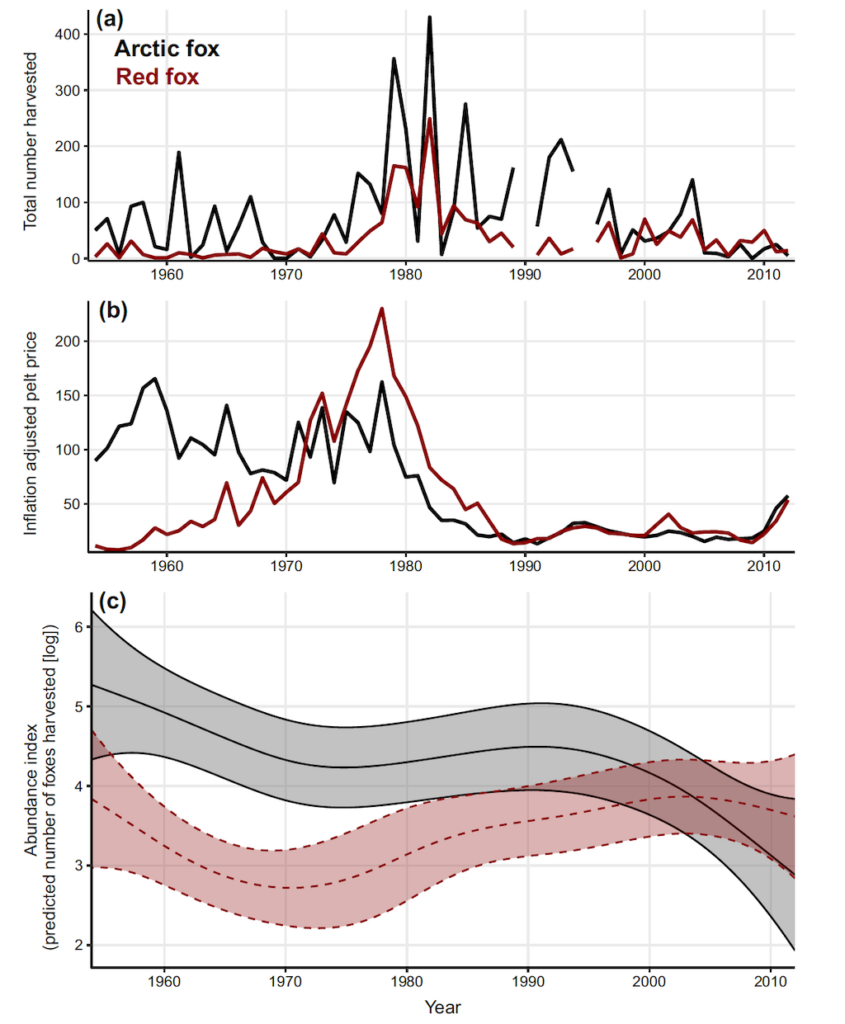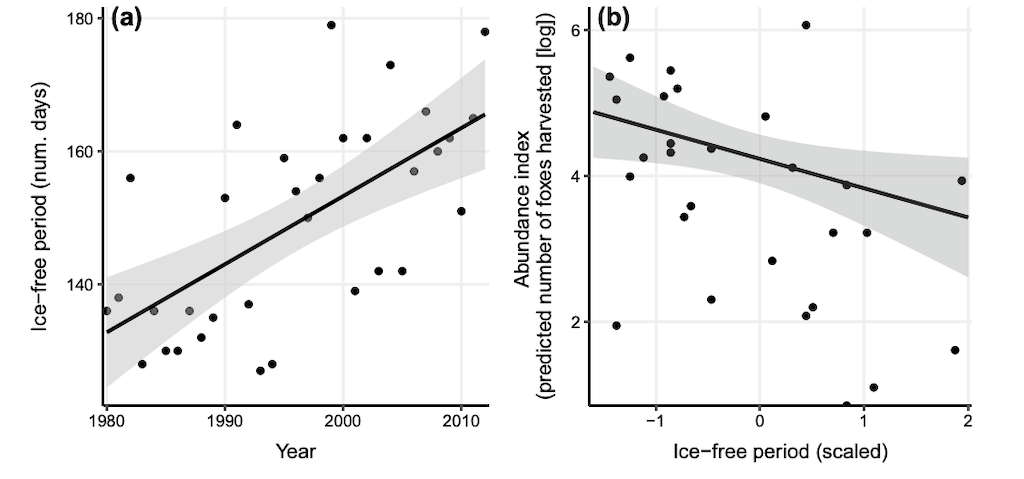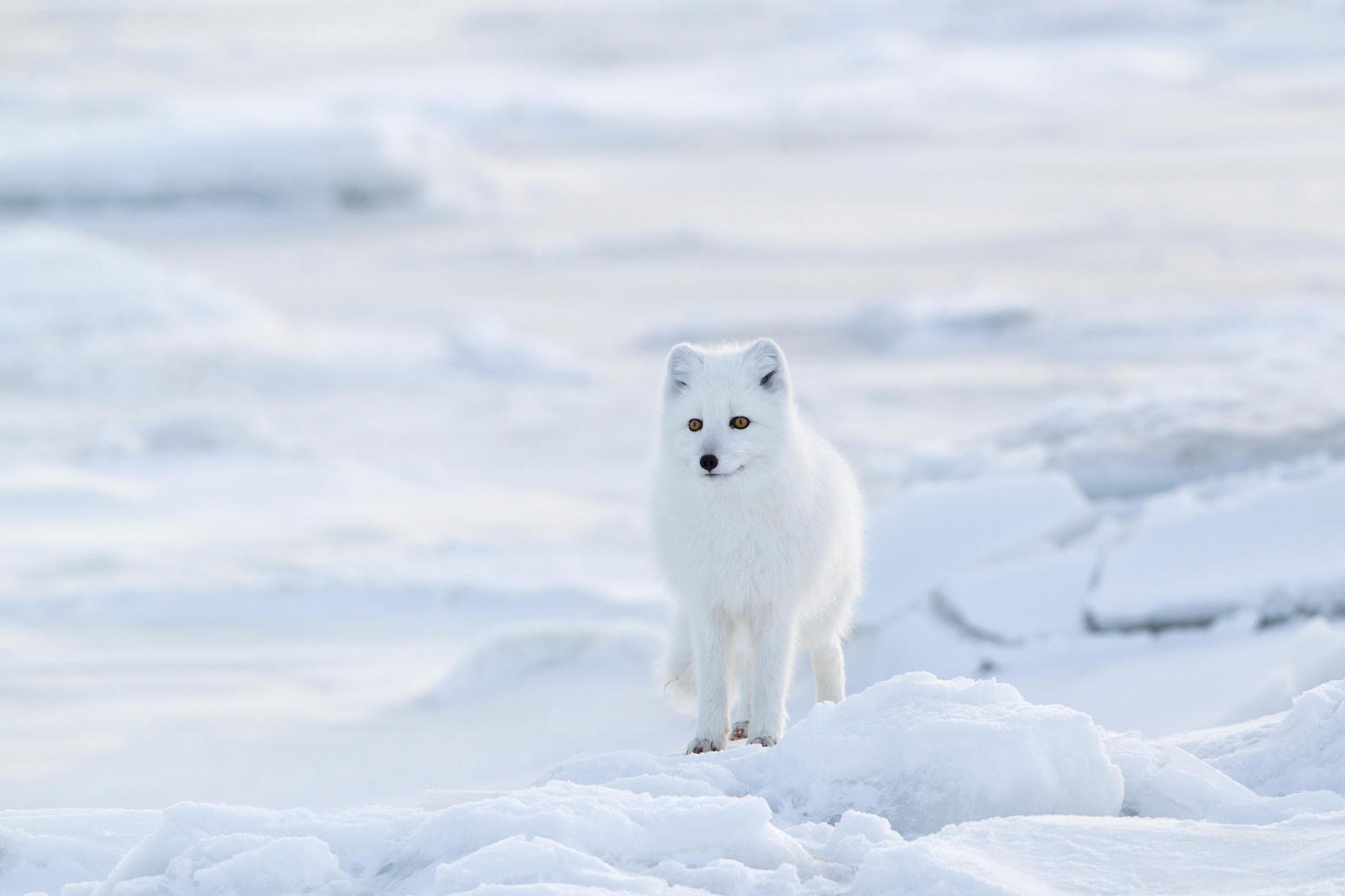The fast disappearance of sea ice in Canada’s Hudson Bay could be linked to a decline in Arctic foxes, according to new research.
The study uses fur harvest records over 1955-2012 to examine how populations of both Arctic and red foxes have changed in the bay, located at the Arctic’s edge in north-eastern Canada.
The findings suggest that, from 1990 to 2012, Arctic foxes have declined while red foxes have remained stable. This decline in Arctic foxes is positively correlated to falling sea ice levels in the bay, according to the research.
The researchers did not specifically examine why falling sea ice levels could be linked to declining Arctic fox numbers.
However, they theorise that the disappearance of sea ice could be restricting foxes’ access to food. The animals use sea ice to prey on seal pups, migratory geese and fish. They also sometimes scavenge on seal carcasses left behind by polar bears. But the disappearance of sea ice is affecting polar bears’ ability to hunt.
Overall, Arctic foxes “are a reflection of the Arctic ecosystem in general” in that they are “sensitive to changes in the cryosphere [Earth’s snow and ice]”, a study author tells Carbon Brief.
“Species that are highly adapted to ice covered ecosystems are not going to fare well as the Arctic warms,” a scientist not involved in the study tells Carbon Brief.
Arctic predator
There are two main species of foxes in the Arctic – the red fox and the Arctic fox.
The Arctic is home to more than 630,000 Arctic foxes and they are not currently at risk from extinction, but populations are declining.
Arctic foxes are well adapted to winter temperatures of -34C. They are born with thick fur and their snout, ears and legs are short to conserve heat.
The new study, published in the journal Oecologia, uses local fur harvest records to try to establish how numbers of both Arctic and red foxes have changed in Hudson Bay since the 1950s.
The findings suggest that, from 1990 to 2012, Arctic foxes have declined while red foxes have remained stable.
The researchers then examined how the downward trend in Arctic foxes compared with climate factors, such as changes to sea ice cover, snow depth and duration, and temperature change.
This revealed a positive correlation between Arctic fox decline and falling sea ice levels.
Overall, the findings reinforce how climate change is already having consequences for one of the Arctic’s most iconic predators, says study author Prof James Roth, a biologist at the University of Manitoba, Canada. He tells Carbon Brief:
“[Arctic foxes] are a reflection of the Arctic ecosystem in general, they’re sensitive to changes in the cryosphere.”
Catching foxes
To understand how Arctic and red fox populations in Hudson Bay could be changing, the researchers needed to first find a record of how many foxes lived in the area in the past.
With no long-term population datasets available, the scientists decided to turn to local records of how many foxes were caught for their fur each year between 1955 and 2012.
Using modelling, the research team adjusted the record to account for external factors that may have affected fur harvests beyond population size. These external factors included how many people were hunting foxes each year – which the researchers estimated using a log of the number of trapper licences sold in the area – as well as inflation, which affects fur demand.
When such external factors were accounted for, the records revealed a decline in Arctic foxes from 1990 to 2012.
This is shown on the charts below, which show the total number of Arctic (black) and red (red) fur harvests over 1955-2012 (top), the price for fox pelts (furs) when adjusted for inflation (middle) and an estimate of population size when hunting effort and inflation is accounted for (bottom).

For the next part of the study, the researchers compared the decreasing trend in Arctic foxes to a number of climate variables, including the number of days annually when Hudson Bay is considered to be ice free – the “ice-free period” – as well as changes to snow depth and duration, and summer temperatures.
Since the 1980s – close to when satellite monitoring of sea ice began, the ice-free period in Hudson Bay has increased by more than 20 days, according to the study. (The decline of Arctic sea ice observed over the satellite era is largely down to climate change.)
The researchers found a negative relationship between the length of Hudson Bay’s ice-free period and estimated Arctic fox abundance – meaning more ice-free days are associated with a decline in Arctic foxes.
This is illustrated in the charts below, which shows how the number of ice-free days in Hudson Bay has increased since the 1980s (left) and the negative correlation between the length of the ice-free period and estimated Arctic fox abundance (right).

Going hungry
The researchers did not specifically examine why falling sea ice levels could be linked to declining Arctic fox numbers.
However, in their paper, they theorise that the disappearance of sea ice could be restricting foxes’ access to food.
Arctic foxes have a complex diet. They typically prey on lemmings, small rodents that live in the Arctic tundra.
However, when lemmings are in short supply, they have been known to get resourceful – hunting newborn ringed seals, migratory geese and fish. In addition, they have also been observed scavenging on seal carcasses left behind by polar bears.
The disappearance of sea ice for longer stretches of the year in Hudson Bay could be stopping Arctic foxes from accessing these “important supplementary food sources”, the scientists say in their research paper.
They add that declining sea ice is also affecting hunting opportunities for polar bears, which will have knock-on effects for Arctic foxes:
“Considering sea ice is an important habitat for polar bears to hunt seals, a reduction in polar bear hunting success in response to sea ice freezing later in fall and breaking up earlier in spring may consequently reduce the availability of seals for foxes.”
The new study “has a really nice illustration of all the factors” affecting Arctic fox survival in the Hudson Bay, says Dr Andrew Derocher, an Arctic mammal researcher at the University of Alberta, who was external to the study. He tells Carbon Brief:
“The Arctic fox is a species that is really adapted to the Arctic conditions.
“Species that are highly adapted to ice covered ecosystems are not going to fare well as the Arctic warms. Once you change the fundamental structure of an ecosystem, the species do respond and, for sensitive species, such as the Arctic fox, their abundance is going to drop over time.”
Derocher adds that, with continued warming, Arctic foxes may be driven further north, where sea ice persists for longer periods of the year:
“Once you take away the sea ice, that ecosystem is not going to be very conducive to the Arctic fox. Arctic foxes won’t be endangered anytime soon, or threatened, [but] we’re going to see an erosion of the species at their southern limits.”
Verstege, J. S. et al. (2023) Arctic and red fox population responses to climate and cryosphere changes at the Arctic’s edge, Oecologia, doi:10.1007/s00442-023-05418-6
Sharelines from this story




















Discussion about this post